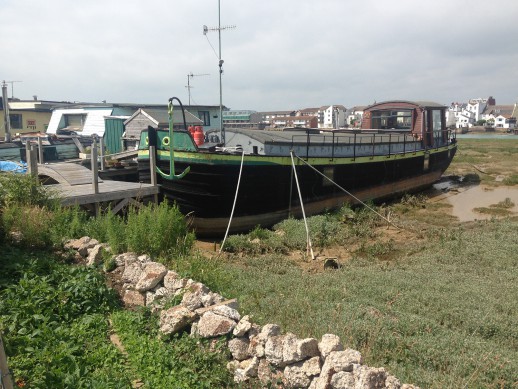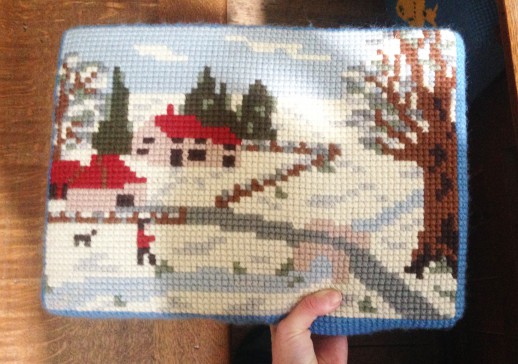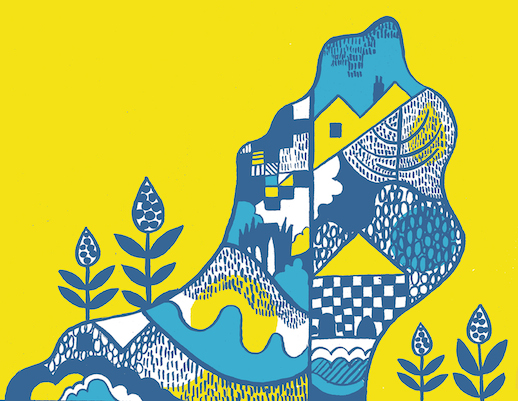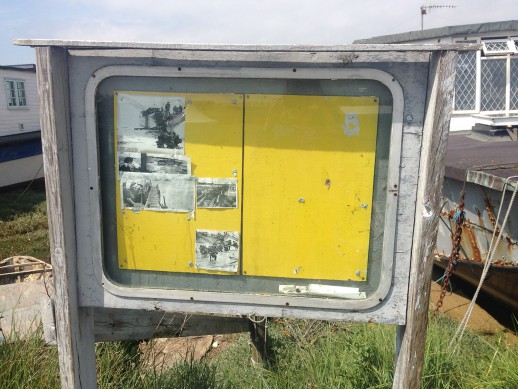Writer and illustrator Alice Stevenson takes a walk around Shoreham-by-Sea
Behind the scattered, pale graves, sits a large, lumpy stone mound surrounded by an iron fence. It is similar in shape and angle to a dead tree trunk, one of its sides slopes into the ground as if to roots. It is the ruined nave of the original, Norman St Mary’s de Haura Church in Shoreham-by-Sea.
The main building of the church has been gradually restored and added to over its 900-year life; it stands calmly in the sunshine, its dignified façade textured with flint. Peter and I walk inside the cool, pale interior and my eyes immediately fall onto the bold graphic compositions of the prayer cushions. English country scenes are rendered with modernist simplicity in bright primary colours. On one, I initially mistake a row of angels for beach huts. Another cushion features a winter scene with a subtler colour scheme: grey and pale blue on white, with perennial trees rendered in muted greens and browns. This cool palette is offset sharply against bright red rooftops. Ambitious attempts at texture and detail have been made; grey shadows on the snow and bark on the trees. Within the limited needlepoint structure of squares of wool, these details become distorted and strange. A figure in red and a dog stand in the snow like characters from a 1980’s video game.
These simpler renditions of the landscape are reflected in our view as we wind up towards Upper Shoreham Road, through respectable streets of early twentieth-century suburban houses. The occasional flint garden wall echoes the nearly millennial site we’ve just been standing on. The soft slope of the South Downs begins to emerge above the triangular rooftops and chimneys. Something about the sight of the Downs always triggers a pang of melancholic nostalgia in my stomach – for childhood visits to my grandparents in Amberley, and escaping Brighton for walks and picnics as an art student. Soft treetops cover the hills, cloudlike clumps in varying hazy shades of green. They cluster around the spikey structure of Lancing College. I imagine reaching out to touch it and my fingers being pricked by its spires.
We make our way down to the bank of the River Adur that flows out to the sea. On the other side, the green Down blanket meets the white, art deco buildings of Brighton City Airport; small planes buzz around like insects and hundreds of pink Valeriums cluster below our feet.
Peter is taking me to see the House Boats that reside on the shingle spit that branches out from the west of the River Adur; a row of forty, no-longer-seaworthy old torpedo boats and oyster catchers that have been gradually converted to homes over the past thirty or so years. Appropriately, as we near the harbour front, a group of primary school girls, bearing clipboards, ask us to take part in a questionnaire about Shoreham and in particular the houseboats and their value to the community. Across the water, the intricate system of ramshackle boat dwellings perch on the mudflats as we answer their earnest questions. We say goodbye to the girls and a shadow of concern descends upon us and we wonder if perhaps the houseboat community is in danger of removal at the hands of property developers, as is the common fate of so much that makes the UK interesting and varied. We follow Old Shoreham Road, veering away from the water’s edge into the pleasantly bustling harbour front.
To our left, I notice a building shaped like a child’s drawing of a house, with dark and light, stone chessboard squares and little, arched doors and windows. It is the Marlipins Museum and is thought to date back to the twelfth century and be the oldest secular building in Sussex. I am struck by the intricate historical and visual richness of this suburban seaside town that I never bothered to visit in the whole three years that I lived in Brighton.
Owing to the footbridge being closed for repairs, we end up taking a rather roundabout route via shuttlebus to our destination on the opposite side of the bank. We wiz past the angular walls and sculpted green mounds of the Old Shoreham Fort at the far tip of the spit. I am surprised to learn this was home to a thriving film studio in the early 20th century, leading to the locality being known as “Hollywood on Sea”. Knowledge of this past glamour injects the atmosphere of the place with a gentle poignancy.
We dismount and walk westerly along the towpath on the bank of the Adur, looking out across the mudflats to Shoreham Harbour. The houseboats begin on our right. Some are particularly striking: Verda has large petal shaped windows at its front and an old bus somehow absorbed into its body like a terrifying robot insect from the future. While the houseboats themselves are fascinating in their individuality and ingenuity, what is most striking to me is all the ‘stuff’ surrounding them. Every deck that connects the boat with the tow path seems to house about a hundred items: watering cans, boots, bathtubs, endless piles of timber, piping, tanks, tools, flower pots, trays of seedlings, washing lines and bicycle wheels. To the left of the towpath is a metre or so drop, reachable by wooden steps. This lower realm houses allotment-style gardens featuring much of the same accoutrements as the boat decks, with additions of chicken coups and bathtubs full of lavender and heaps of firewood.
Yet it doesn’t feel chaotic, everything seems to have its own purpose and a sense of logic that I don’t understand but instinctively respect. There are very few people around and an old wooden information board stands along the towpath, bleached by the sun and salt. Under the glass, a few black and white photographs of a boat at sea, are randomly arranged on bright yellow paper. Beyond the allotment gardens, the backs of bungalows and clapboard houses are only metres away but seem to belong to a different planet. We pass under an abundant arch of elder and ahead of us is an estate agent’s sign sticking out of a houseboat. This symbol of the conventional property world is jarring in these surroundings.
As we pass the last boat, I think back to the ruined nave of St Mary de Haura and the brightly coloured, pixelated scenes depicted on its prayer cushions, and I marvel at how many different worlds past, present and imagined I have glimpsed within just a couple of square miles.



